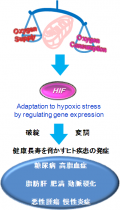Elucidating the mechanisms of intrahepatic metabolism control and disease caused by its failure

- researcher's name
- affiliation
- research field
-
Pathological medical chemistry,General medical chemistry,Environmental physiology (including physical medicine and nutritional physiology)
- keyword
-
background
The liver is the central organ involved in metabolism within the body, and a drop in its function can be life threatening. Metabolism function in the liver is controlled by hormones and other liquid factors, but in recent years, autonomous control mechanisms have also been noted as important. A low oxygen environment is recognized as a basic common condition to a range of hepatic disorder patients, including those with fatty liver, hepatitis and liver fibrosis. It has gradually become clear that poor adjustment to a low oxygen environment is closely linked with failure in hepatic metabolism control.
summary
We have findings about the central molecule involved in the low-oxygen response mechanism in cells, hypoxia inducible factor (HIF)-1. We discovered that failure in this response in hepatic parenchymal cells leads to the onset and development of alcoholic and non-alcoholic fatty liver. In particular, we clarified that failure of fatty acid metabolism control by HIF-1 is involved in the onset mechanism for alcoholic fatty liver disease. Research is also being extended into the involvement of HIF-2, the HIF isoform.
application/development
It is thought that liver disease onset and development can be controlled by developing low-molecular compounds that target HIF and delivering them specifically to the liver.
predominance
Human disease models have been reproduced on an individual level and efforts are underway to elucidate the disease onset and development mechanisms mediated by metabolism control by HIF. Using in vivo imaging technology with biomicroscopy systems, we are analyzing the interactions between cancer cells and host-side interstitial and immunocompetent cells, and working to reveal the pathobiological significance of the low-oxygen environment in this interaction.
purpose of providing seeds
Sponsord research, Collaboration research, Technical consultation
same researcher's seeds
posted:
2014/05/21




